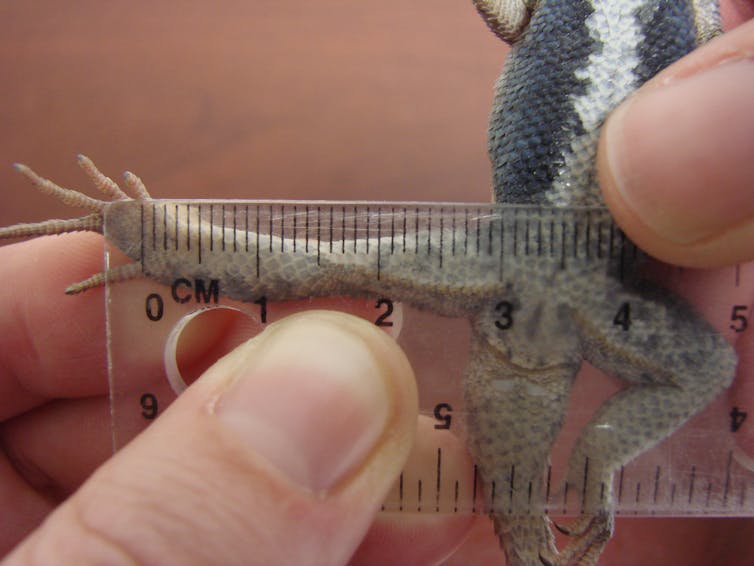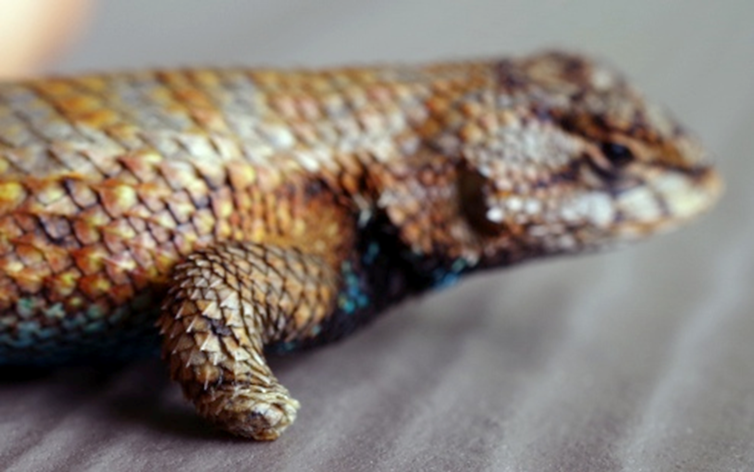Native eastern fence lizards changed their bodies and behavior in response to invasive red imported fire ants - The Conversation Indonesia
An eastern fence lizard basking in the sun feels a small red ant walk over its back. Not hungry, it ignores the insect. Soon there are lots of ants crawling up its legs, biting the scales that usually protect it and inserting their stingers in its soft underlying flesh.
Not having evolved with this threat, the lizard adopts its typical defensive posture of lying flat and closing its eyes, counting on its natural camouflage to protect it. This can be a deadly decision, though. As few as 12 of these ants can kill an adult lizard in less than a minute.

Such interactions are now common in the southeastern United States, where native animals such as eastern fence lizards (Sceloporus undulatus) have shared their habitat with the invasive red imported fire ant (Solenopsis invicta) for decades.
Our research group has been studying the interactions between these two species and how they change over time. These small lizards, about 6 inches (15 centimeters) from nose to the tip of the tail, have been native to the southeastern United States for thousands of years. Invasive red imported fire ants are originally from South America but were unintentionally introduced to the port of Mobile, Alabama, in the 1930s and have steadily spread northward – into the lizards' territory – since their introduction.
We're particularly interested in how animals may adapt to coexist with venomous species. The fire ants' well-documented path of invasion, and the fact that they are currently restricted to just a portion of the lizards' range, allows us to compare how lizards from ecologically similar areas differ based on the presence or absence of these fire ants. Overall it seems the lizards are learning to live with the invaders, adapting their behavior and bodies to better survive attacks from the ants and using them as a new food source.
Changing looks and behavior to survive attacks
Lizards and fire ants require a similar habitat to survive – open and often disturbed patches of land that let in sunlight. We've found that lizards don't avoid areas where fire ants are and they don't avoid their scent. It would be difficult to do, anyway, given how ubiquitous these ants are – within the areas they've invaded, fire ant mounds can dot the landscape every few meters.
Foraging fire ants can locate a basking lizard within minutes and quickly recruit other ants to attack. All is not lost for the lizard, however. Some do what you probably would when attacked by fire ants: flick them off and move away. This twitch-and-flee behavior removes scout ants, preventing them from recruiting reinforcements, and also gets rid of any other ant attackers.
This behavior is common in baby fence lizards, which are vulnerable even to native ants, but is usually lost in adults as they outgrow threats from native ants by getting larger. However, in areas with fire ants, adult lizards retain this behavior that better enables them to survive fire ant attack.
Lizards can't tell whether they have a potentially deadly fire ant crawling on them or if it's something harmless like a fly. So, to be safe, they respond in the same way to anything that they feel climbing on their scales. Unfortunately, this shake-it-off behavior doesn't solve all the lizards' problems, since it breaks their usual camouflage, making them more obvious to visual predators like birds. We have observed more evidence of wounds in fire ant-adapted lizards. And a lizard that survives a fire ant attack can still die weeks to months later, though we're not sure yet why.

We find lizard populations that have been living with fire ants have adapted to have longer legs, which are better at removing fire ants when a lizard twitches and flees. This is a big shift for this species, reversing the latitudinal pattern we see in museum specimens – lizards tend to have shorter limbs the closer the population is to the equator. Since limb length can have important implications for how animals move around their environment, this anatomical change could have important consequences.

Venomous predator can also be prey
These lizards, especially when they are young, eat a lot of ants of various types. Eating a fire ant, though, can mean getting stung inside the mouth, which can make this a lethal meal. Baby lizards quickly learn to avoid eating fire ants, but this leads to their also avoiding their native ant diet, the consequences of which are unknown.
Adult lizards, on the other hand, are less vulnerable to succumbing to consumed fire ants and take advantage of this new food source. So there's an upside to these troublesome insect invaders for fence lizards.
Physiological changes triggered by fire ants
Lethal outcomes are the most striking consequence of interactions between fire ants and fence lizards, but that's not the full story.
As you might imagine – or even have experienced – being stung by fire ants is stressful for lizards, as indicated by an increase in a stress-relevant glucocorticoid hormone following attack, just as you would experience after getting a scare.
We find that lizards that frequently experience fire ant attacks have a different "stress profile." They have higher concentrations of this stress hormone even while at rest. They show greater increases in glucocorticoids in response to a stressor and have different behavioral and immune responses to glucocorticoid exposure. While stress gets a bad rap, these hormones play an important role and in this case can trigger survival-enhancing behavioral responses to fire ants.
Lizards living with fire ants show changes to their immune systems. They have elevated levels of IgM antibodies that respond to fire ants and higher levels of a type of white blood cell that can help neutralize venom toxins. They also have decreased levels of other immune system components. Together, these immune differences may allow lizards to better coexist with fire ants, with the elevated immune measures being particularly useful when dealing with stings. Tailoring the immune system to survive fire ant attacks may, however, leave lizards more vulnerable to other immune challenges, such as viruses.
Getting stung over a period of time stimulates lizards' skin immunity, which could guard against effects of skin damage. Additionally, feeding on fire ants that we've rendered in the lab incapable of stinging increases some immune measures in the lizards above what we see in lizards that were stung by fire ants. This bolstered immunity may then help lizards survive future stings. We think the elevated immunity we see in wild lizards in fire ant-invaded places may be caused by consumption of fire ants.

Animals adapt – but there can be consequences
The effects of invasive fire ant and eastern fence lizard interactions demonstrate how species can adapt to survive the presence of invasive predators. Behavioral shifts can allow animals to avoid or escape attack, and changes in morphology can make these strategies more effective. And eating venomous prey may provide immune protection against subsequent attack.
However, this research also illustrates that adaptations are not a panacea. While adapting to a changing world is clearly critical for survival, by its very nature this changes animals, pushing them off their original evolutionary trajectory and leaving them vulnerable to new threats. Getting a full picture of the consequences of the presence of a new threatening species, and of the changes that animals may need to make to survive them, is critical if scientists are going to be able to predict and manage the impact of invasive species on native communities.

Comments
Post a Comment